
The Definitive Guide to Choosing a Necropsy Table
Understanding Necropsy Tables: The Foundation of Veterinary Pathology
A necropsy table is a specialized workstation designed for post-mortem animal examinations in veterinary medicine. If you're looking for information about necropsy tables, here's what you need to know:
| Necropsy Table Essentials | Description |
|---|---|
| Primary Function | Platform for animal post-mortem examinations |
| Common Materials | 304 stainless steel (most hygienic and durable) |
| Key Features | Drainage systems, raised edges, ventilation options |
| Standard Sizes | Small (36"×84") to Large (48"×108") |
| Types | Rectangular, U-shaped, Downdraft, Mobile, Stationary |
| Price Range | $2,000-$22,000 depending on features |
The necropsy table serves as the cornerstone of veterinary pathology work, providing a sanitary, efficient workspace for post-mortem examinations that help determine causes of death, identify diseases, and advance animal medicine. Unlike their human counterpart (autopsy tables), necropsy tables are specifically designed to accommodate various animal species and sizes.
"The cursory autopsy, with lack of attention to detail... can only yield missed opportunities," notes a veterinary pathology manual, highlighting why proper equipment is crucial for thorough examinations.
A well-designed necropsy table isn't just about having a flat surface—it's an integrated system that manages fluids, provides proper lighting, ensures ergonomic access, and maintains biosafety standards during potentially hazardous procedures.
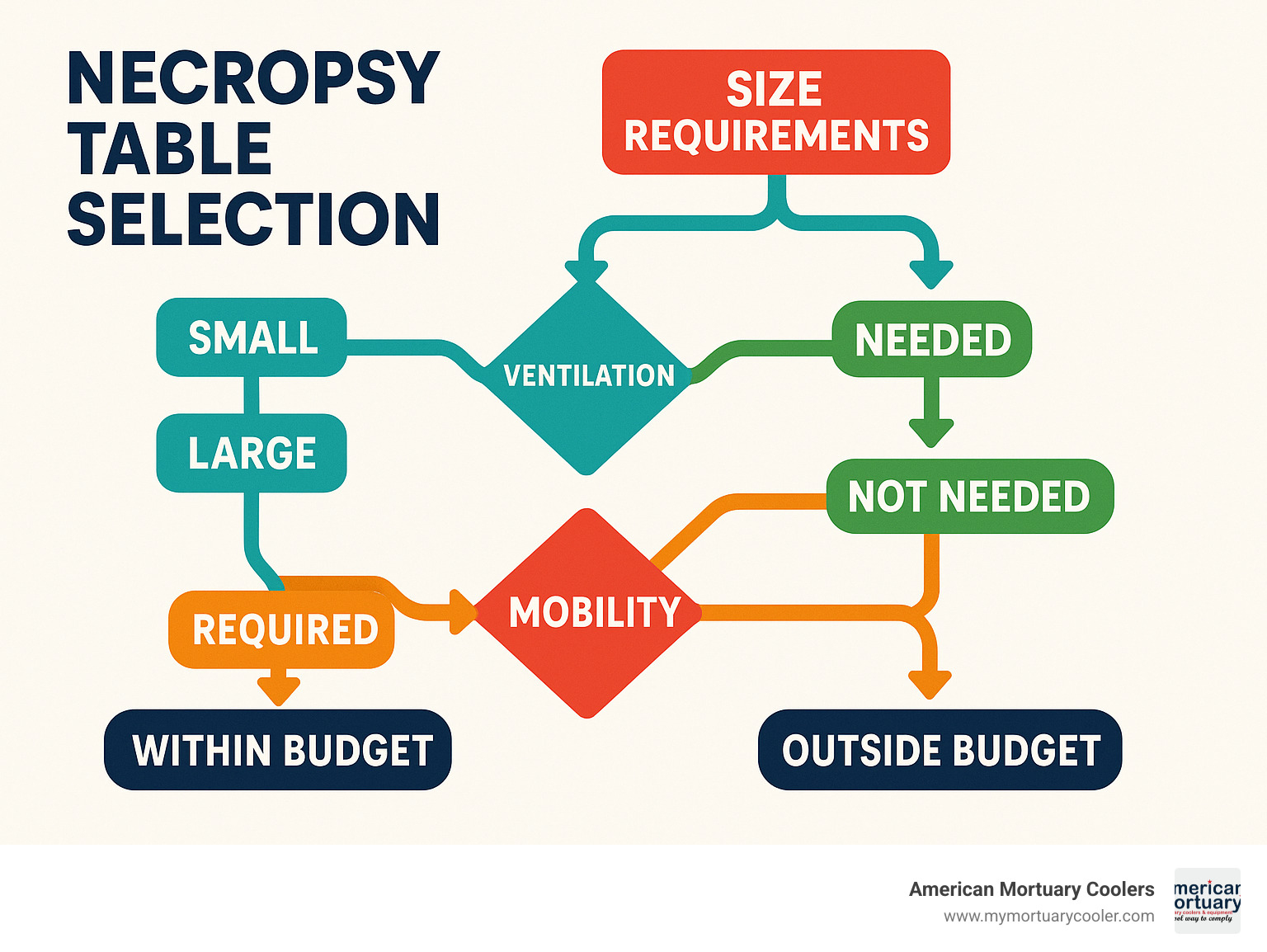
Necropsy Table Fundamentals: Definition, Function, and Anatomy
What Is a Necropsy Table?
A necropsy table is where animal medicine reveals its final secrets. Think of it as the specialized platform where veterinary professionals perform post-mortem examinations—the word "necropsy" itself tells the story, coming from Greek roots meaning "to view the dead." Unlike tables designed for human autopsies, these workstations are engineered to handle everything from tiny mice to massive horses.
When veterinarians need to determine why an animal died, study how a disease progressed, or advance research, the necropsy table becomes their most trusted partner. It's more than just a surface—it's the foundation for diagnostic work that impacts animal health, research outcomes, and even human health through the monitoring of diseases that can jump from animals to people.
As one veterinary pathology manual puts it: "Postmortem examination remains the most efficient and cost-effective method for investigating disease pathogenesis, despite imaging advances."
Core Components Explained
When you look at a quality necropsy table, you're seeing several carefully designed elements working together:
The drainage system is perhaps the star of the show. A well-designed table includes strategically placed drain ports and a subtly sloped surface—typically built with a 1-inch slope—that naturally guides fluids toward these drains.
Around the edges, you'll find tie-down rails that allow veterinarians to secure specimens in position for examination. The more advanced models feature special sockets at corners for attaching specialized equipment.
Many tables incorporate removable perforated grid plates, typically made of sturdy 14-gauge material. These clever panels support the specimen while allowing fluids to drain away.
If mobility matters to your facility, look for models with 5-inch diameter swivel casters, all equipped with reliable braking mechanisms. The best designs feature stabilizing casters that provide smooth movement while maintaining stability during procedures.
Every good necropsy table features a marine edge—that raised lip (typically ¾ inch high) that runs around the perimeter to contain fluids and prevent spillage.
For ergonomic comfort, many models include a hydraulic scissor-lift base that allows height adjustment, protected by accordion-style bellows that allow for complete washdown while keeping mechanical components safe.
Necropsy Table Types and Designs
The world of veterinary medicine has inspired several specialized necropsy table designs to accommodate everything from hamsters to horses. Each configuration offers unique benefits depending on your facility's needs.
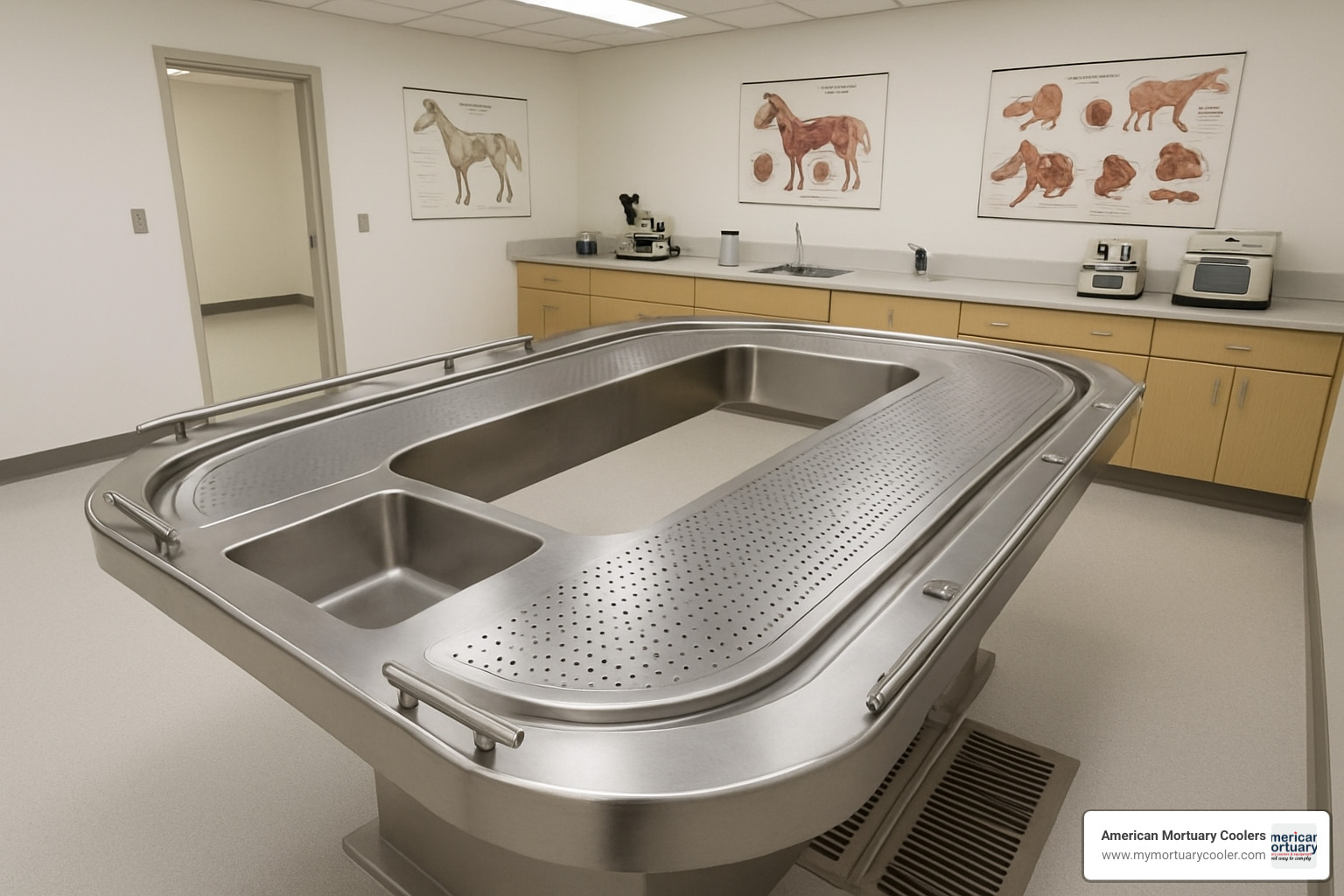
Rectangular Necropsy Table Overview
The rectangular necropsy table is the workhorse of veterinary pathology labs. These versatile tables come in various sizes, typically ranging from 36"×84" models perfect for smaller animals to spacious 48"×108" versions for larger specimens.
What makes these tables so popular is their accessibility – technicians and pathologists can easily work from any side, which is particularly helpful during collaborative examinations. The straightforward design provides uniform drainage toward one or both ends.
As one client told us, "Having 360-degree access to our specimens has cut our examination time by nearly 30%." The rectangular design also works well with overhead lighting systems and makes efficient use of laboratory space.
Downdraft Necropsy Table Advantage
If you've ever found yourself backing away from a particularly pungent specimen, you'll appreciate the genius of downdraft necropsy tables. These tables represent a breath of fresh air – quite literally – in workplace safety and comfort.
Downdraft systems pull air downward through the work surface, whisking away unpleasant odors and potentially harmful vapors before they reach your breathing zone. This technology keeps formalin, alcohol, and xylene levels well below OSHA-permissible exposure limits.
"The difference is night and day," shares Dr. Melissa Chen, a veterinary pathologist at a university teaching hospital. "Before our downdraft table, we'd all have headaches by lunchtime. Now we can focus entirely on the examination."
U-Shaped Necropsy Table for Education
Teaching the next generation of veterinary professionals requires specialized equipment, and the U-shaped necropsy table rises to this challenge. These tables create natural amphitheaters for learning, accommodating up to 10 students in a single session.
The open center area gives instructors freedom to move while demonstrating techniques, while the continuous viewing space ensures every student has a front-row seat to the learning experience.
These educational powerhouses often come equipped with integrated electrical outlets for demonstration equipment and provide ample space for note-taking and discussion.
Want to learn more about specific necropsy techniques? Check out this detailed Scientific research on necropsy techniques from the University of Calgary.
Key Materials, Features, and Customizations to Evaluate
When shopping for a necropsy table, the materials and features you select will make all the difference in how well it serves your facility.
Why Stainless Steel Reigns Supreme
There's a good reason Type 304 stainless steel has become the gold standard for necropsy tables – it's simply the best material for the job.
Imagine performing necropsies on a surface that stains, harbors bacteria, or corrodes after exposure to bodily fluids. That's why 304 stainless steel shines in this environment. It's remarkably resistant to corrosion, even when regularly exposed to harsh cleaning chemicals and biological materials. Its non-porous surface means bacteria have nowhere to hide.
"We've had our stainless steel necropsy table for over 15 years, and it still looks nearly new with proper care," one veterinary pathologist told me recently.
The thickness matters too. When comparing specifications, pay attention to the gauge – 12-gauge provides exceptional durability, while 14- or 16-gauge options might save money upfront but won't stand up to heavy use as well.
Quality tables feature Heliarc (TIG) welded seams that are ground smooth and polished to match the surrounding surface. These seamless joints eliminate hiding spots for bacteria.
Must-Have Safety & Workflow Boosters
Beyond the basic structure, several features can dramatically improve your daily necropsy experience:
Good lighting makes all the difference in accurate diagnoses. Built-in LED task lighting eliminates shadows and provides consistent illumination.
Working with electricity around water always raises safety concerns, which is why integrated GFCI outlets are a must-have. These specialized receptacles protect staff from electrical shocks.
Downdraft ventilation systems pull harmful vapors downward and away from breathing zones, keeping formalin and other chemical exposures well below OSHA limits.
Splash guards might seem like a small addition, but they can be lifesavers during high-pressure rinses or unexpected fluid releases.
For large animal facilities, tie-down bars and scale mounts transform a simple table into a complete workstation.
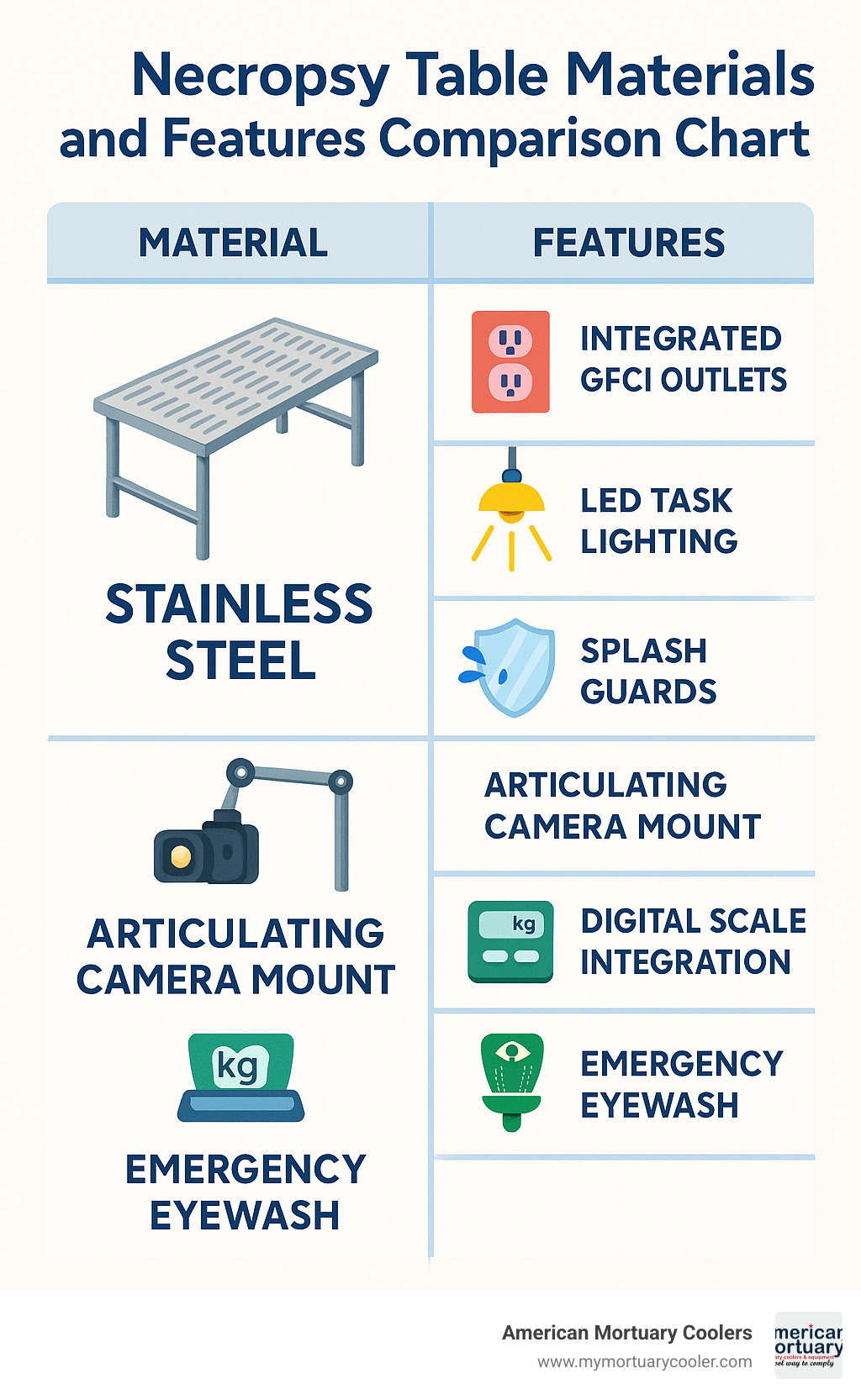
Custom Builds for Unique Lab Needs
Every veterinary facility has its own workflow and specialties. That's why custom necropsy table options can be game-changers for efficiency.
If you primarily work with large livestock, you'll need different dimensions than a lab focusing on companion animals or laboratory specimens.
Some facilities benefit from built-in imaging rails that allow radiographs to be taken without moving the specimen. Others find integrated specimen sinks invaluable for organ washing and sample preparation without cross-contamination risks.
Camera arms provide stable mounting points for documentation – essential for teaching hospitals or forensic cases where visual records are crucial.
Ergonomics, Hygiene, and Maintenance Best Practices
Taking care of your necropsy table isn't just about protecting your investment—it's about protecting your staff and ensuring accurate diagnostic results.
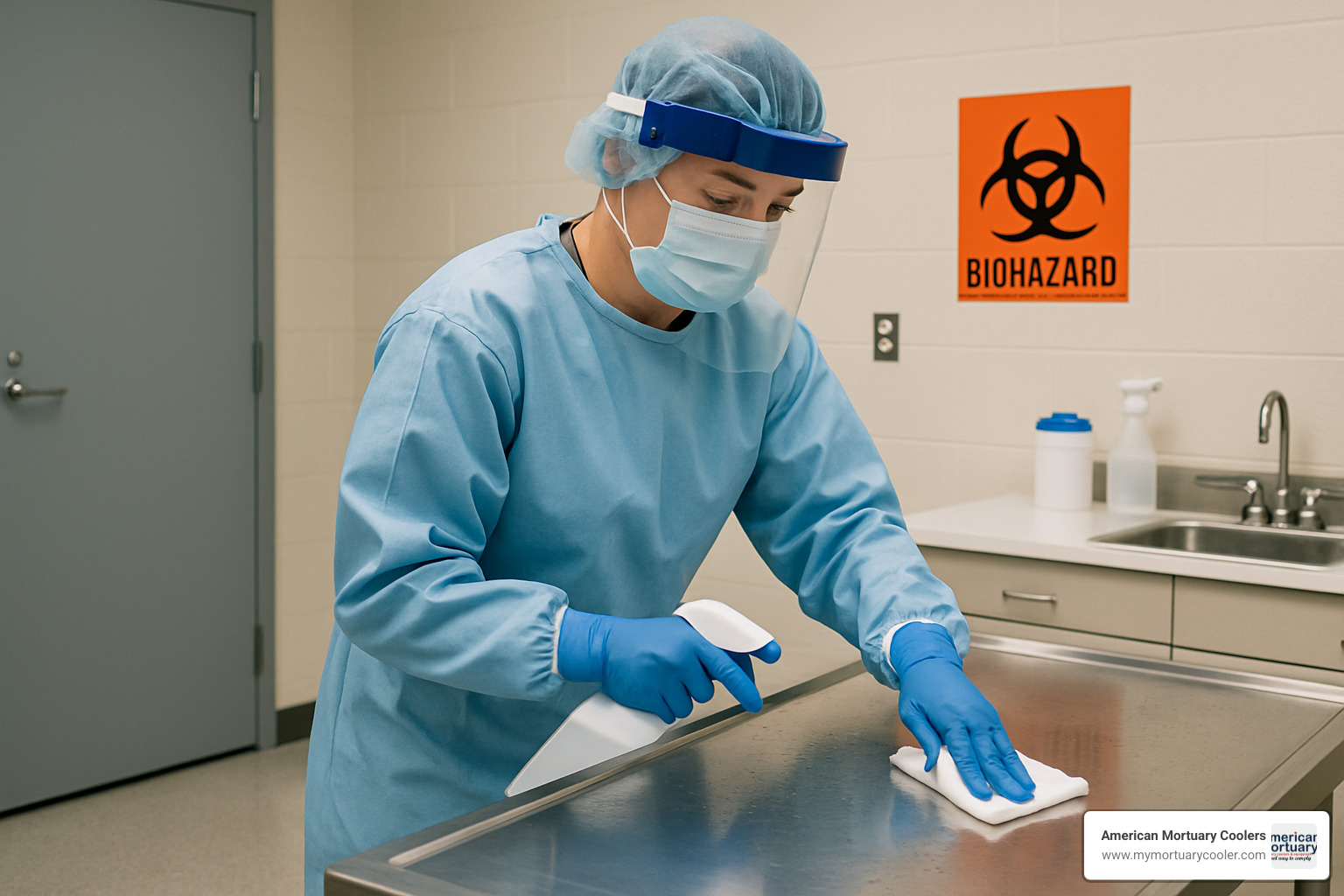
Cleaning & Disinfection Protocol
Let's face it—necropsy work is messy. Keeping your necropsy table properly sanitized prevents cross-contamination and protects your team from potential zoonotic diseases.
Right after each procedure, give your table a thorough rinse. That gentle slope built into your necropsy table isn't just for show—it's designed to channel fluids efficiently toward the drain.
Next comes the actual cleaning step. Choose a neutral pH detergent specifically made for stainless steel surfaces. I've seen too many beautiful tables damaged by harsh chloride cleaners that pit the surface over time.
For disinfection, a 10% bleach solution works well for general purposes, but you might need something more specialized depending on the pathogens you're dealing with. Whatever you choose, let it sit for the full recommended contact time (usually about 10 minutes).
"The most common mistake I see is rushing the disinfection process," one of our veterinary clients told me recently. "Those ten minutes really make all the difference in preventing cross-contamination."
Always finish with a thorough rinse to remove chemical residues. Let the table air dry completely or wipe it down with clean, lint-free cloths if you're in a hurry.
Routine Maintenance Checklist
Even the best necropsy table needs regular TLC to stay in top condition. Think of this quarterly maintenance routine as preventive medicine for your equipment.
Start by checking that all drain ports flow freely. A blocked drain can quickly turn your next procedure into a messy disaster.
For mobile tables, give those casters some attention. All four should rotate smoothly, and the brakes should engage firmly.
If you have a height-adjustable table, listen for any unusual noises when raising or lowering it. That could indicate air in the hydraulic system.
Take a close look at all welded joints, especially in high-stress areas like leg attachments. Quality necropsy tables feature seamless Heliarc welds, but even these should be inspected periodically.
Don't forget to examine the table surface itself. Minor scratches can often be buffed out with appropriate stainless steel polishing compounds.
For downdraft tables, verify airflow to maintain proper function and keep your lab air clean and safe.
Electrical components deserve special attention in the wet environment of a necropsy lab. Have qualified personnel test all electrical outlets, particularly GFCI protection.
Selecting, Integrating, and Using Your Necropsy Table
Choosing the right necropsy table for your facility doesn't have to be overwhelming. Think of it as finding a trusted partner that will support your important work for years to come.
Step-by-Step Buying Framework
Finding your perfect necropsy table starts with honest self-reflection about your needs. What animals do you typically examine? How many cases do you handle in a typical week?
Your available space matters tremendously. Measure your space carefully, including doorways and hallways that equipment must pass through.
Budget conversations might not be exciting, but they're essential. While price matters, value matters more. As one client told me, "I wish I'd spent the extra money on height adjustability from the beginning—my back would thank me!"
Once you've clarified your needs, prioritize features based on your specific workflow. Not everyone needs a mobile table or downdraft ventilation. Ask yourself which features would make the biggest difference in your daily work.
Before finalizing your selection, thoroughly review the specifications. Pay special attention to load capacity—especially if you'll be handling large animals.
When comparing quotes, look beyond the sticker price. Consider shipping costs, installation requirements, and long-term maintenance needs.
Finally, don't underestimate installation planning. Address details like floor load capacity, utility connections, and staff training well before delivery day.
Optimizing Efficiency During Post-Mortem Examinations
Your necropsy table isn't just equipment—it's the foundation of your diagnostic workflow. Small adjustments in how you use it can dramatically improve your efficiency.
Thoughtful specimen positioning makes all the difference. For ruminants, positioning with the left side down minimizes organ displacement and provides better access to the digestive system. Use those tie-down bars to secure larger specimens!
Create an intuitive tool arrangement around your workspace. Position frequently used instruments within easy reach, and consider using magnetic strips for keeping sharp tools secure but accessible.
Sample collection becomes streamlined when you establish dedicated zones on your table. Many professionals create an unspoken map: fresh samples for microbiology to the left, histopathology specimens straight ahead, toxicology to the right.
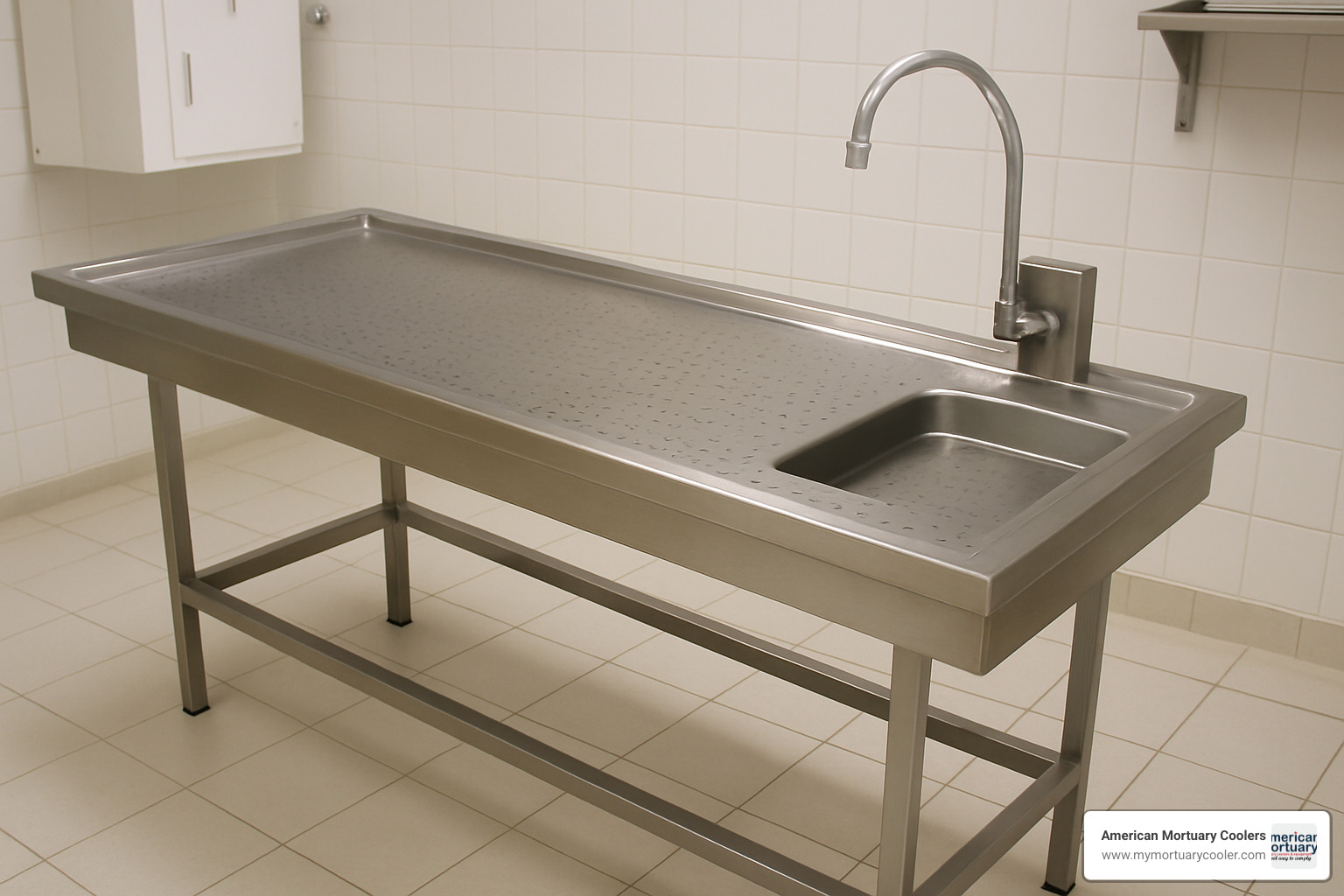
Frequently Asked Questions about Necropsy Tables
How do necropsy tables handle small vs large animals?
When it comes to accommodating different animal sizes, necropsy tables are remarkably versatile. For smaller patients—those under 50 pounds like cats, small dogs, and laboratory animals—a standard 36"×84" rectangular table provides plenty of workspace. The perforated grid plates lift these smaller specimens for better drainage and visualization.
For medium-sized animals between 50-500 pounds (think larger dogs, small pigs, or young sheep), you'll want to step up to a 48"×96" table. These models feature reinforced construction to handle the additional weight and typically include deeper marine edges to contain the greater volume of fluids.
When you're working with truly large animals—horses, cattle, or other livestock over 500 pounds—you'll need specialized equipment. These heavy-duty necropsy tables support centralized loads up to 5000 pounds and offset loads up to 2500 pounds. They often incorporate hydraulic lift systems that allow you to adjust the height even under substantial weight.
What ventilation rate is recommended for a downdraft necropsy table?
Air quality is non-negotiable in a necropsy environment. For downdraft necropsy tables, getting the ventilation right is absolutely critical.
Industry standards recommend a face velocity of 50-100 feet per minute (fpm) at the work surface. In practical terms, this translates to a total air volume exchange of 500-1000 cubic feet per minute (CFM) for a standard-sized table. You'll also want to maintain a negative pressure differential of 0.05-0.10 inches of water column to ensure fumes are consistently pulled downward.
These specifications aren't arbitrary—they're carefully calculated to keep "formalin, alcohol, and xylene levels below OSHA-permissible exposure limits."
Quality downdraft systems incorporate internal baffles that ensure even distribution of exhaust along the entire table length. This prevents "hot spots" where vapors might escape upward.
How often should I deep-clean and service my necropsy table?
Maintaining your necropsy table is like caring for any precision instrument—regular attention prevents bigger problems down the road.
After each procedure, give your table a thorough rinse and disinfection. Flush the drains with high-pressure water and remove any perforated grid plates for separate cleaning.
Weekly, take time to clean all surfaces, including the underside of the table. Check drains for any tissue buildup that might cause blockages.
Monthly deep cleaning should include appropriate stainless steel cleaners to maintain that pristine finish. This is also a good time to inspect all welds and joints.
Quarterly, schedule a more thorough inspection of hydraulic systems, test all electrical components, and verify that your ventilation system is performing to specifications.
Annually, invest in complete preventive maintenance by qualified technicians. Think of it as your table's yearly physical—catching small issues before they become major problems.
Conclusion
Choosing the right necropsy table isn't just about buying equipment—it's about investing in a foundation for quality veterinary pathology. Throughout this guide, we've walked through everything from basic components to specialized designs, helping you understand what makes a truly effective workspace for post-mortem examinations.
The perfect necropsy table balances several crucial elements: functionality that matches your procedures, durability through quality stainless steel construction, safety features that protect your team, thoughtful ergonomics to prevent fatigue, and smart hygiene design for thorough cleaning.
I've seen how cutting corners on equipment leads to frustration down the road. As that veterinary pathology manual puts it: "The cursory autopsy, with lack of attention to detail... can only yield missed opportunities."
Here at American Mortuary Coolers, we understand that every veterinary facility has unique needs. The species you examine, the procedures you perform, and the space you have available all shape what equipment will serve you best. That's why we don't just sell tables—we guide our clients through the selection process, ensuring you invest in a necropsy table that truly fits your requirements.
We're proud to be based in Tennessee, providing specialized equipment to clients across all 48 contiguous states. Our commitment to durability and custom design has made us a trusted partner for veterinary facilities nationwide.
For more information about our custom necropsy tables and other specialized equipment, explore our other resources like our guide to morgue equipment options or our overview of autopsy tables. Or better yet, reach out directly to our team. We're ready to help you design a solution that perfectly matches what you need.



